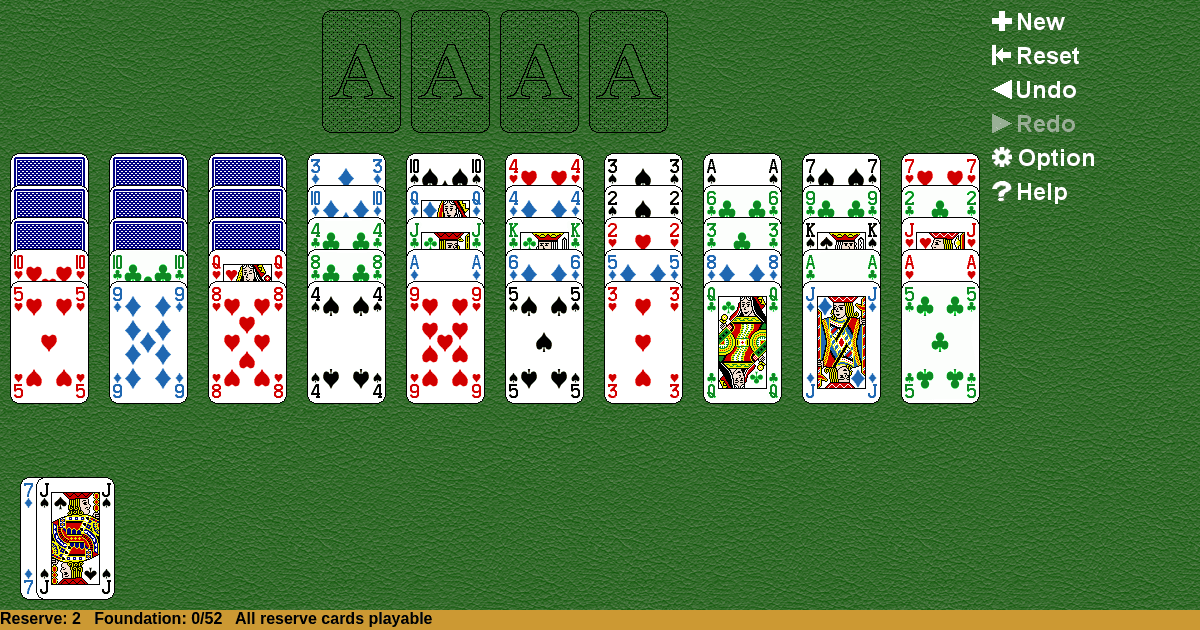Three Blind Mice
Home |
How to play |
FAQ |
About
How to play Three Blind Mice?
Game Objective:
The primary goal in Three Blind Mice Solitaire is to create and discard four complete sequences of cards, each running from King down to Ace in the same suit, within the tableau area. The game is won when all cards have been organized into these sequences and removed from play.
Setup & Layout:
- Deck: Standard 52-card deck is used.
- Tableau: Ten tableau piles are created. Each pile is dealt five cards. In most implementations, all cards are dealt face-up.
- Reserve: Two cards remain after dealing to the tableau. These are placed as a reserve (sometimes called "the mice") and are available for play at any time.
- Key Play Areas:
- Tableau: The main area where cards are built into sequences.
- Reserve: A small holding area with two face-up cards available for play onto the tableau.
- Foundations: There are no traditional foundation piles. Instead, completed sequences are removed directly from the tableau.
Three Blind Mice Solitaire Rules:
- Building Sequences:
- Cards in the tableau build down in the same suit (e.g., 9♥ can be placed on 10♥).
- Only Kings may be placed in empty tableau spaces.
- Groups of cards (any number of cards from the top of a pile) may be moved together, regardless of their internal order or suit. However, the destination pile must follow the "down in suit" rule for the top card.
- Moving Cards:
- Any face-up card, along with all cards stacked above it, may be moved as a group.
- The top card of the reserve may be played onto any tableau pile, following building rules.
- Removing Sequences:
- When a complete sequence from King down to Ace in the same suit is formed in a tableau pile, that sequence is immediately removed from play.
Gameplay:
- On each turn, the player may:
- Move a single card or a group of cards from one tableau pile to another, building down in suit.
- Move a King (or a group headed by a King) into any empty tableau space.
- Play either of the two reserve cards onto any tableau pile, following building rules.
- No new cards are introduced after the initial deal and use of the reserve; all play is within the tableau and reserve.
- If no legal moves are available (no cards can be moved according to the rules), play stops.
Winning & Losing Conditions:
- Win Condition: The game is won when all four complete, in-suit sequences (King to Ace) have been built and removed from the tableau, leaving no cards remaining.
- Loss Condition: The game is lost (unwinnable) if no further legal moves are possible and not all sequences have been completed and removed.
Special Rules & Edge Cases:
- Empty Tableau Spaces: Only a King or a group of cards headed by a King may be moved into an empty tableau pile.
- Moving Groups: Any group of cards from the top of a pile can be moved, regardless of their internal sequence or suit. However, the move is only legal if the group’s bottom card builds down in suit on the destination pile’s top card.
- Reserve Cards: The two reserve cards are always available for play. There is no restriction on when they must be played, but once played, they cannot be replaced.
- Sequence Removal: Completed King-to-Ace sequences in the same suit are automatically removed from the tableau as soon as they are formed.
- No Redeals: There are no redeals or reshuffles; once all moves are exhausted, the game ends.
Definitions of Key Terms:
- Tableau: The main play area where cards are arranged and manipulated.
- Reserve: A small pile (two cards) available for play at any time.
- Sequence: A run of cards in strict descending order (King to Ace) and of the same suit.
- Foundation: In this variant, there are no traditional foundations; completed sequences are simply removed.
This ruleset reflects the most authoritative and consistent interpretations of Three Blind Mice Solitaire from multiple official and reputable sources.

Solitaire Collection
About Three Blind Mice
Rate (Three Blind Mice)
4.7 / 5
1,916 votes



























































